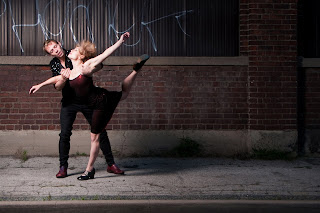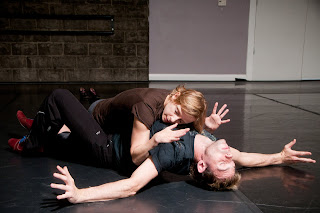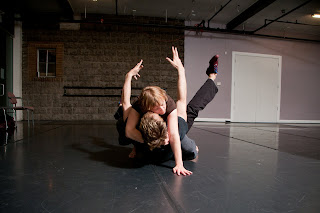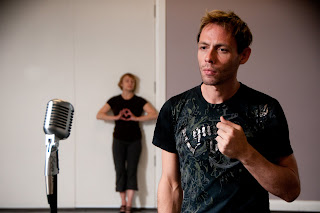“My process is based in a combination of rigorous in-studio explorations of the psyche soma connection, voice work and character study. Both the abstract and the non-linear narrative are represented in my choreography, which is tightly crafted and embraces the creative and embodied performances of the interpreter. Grounded in a physical base that is athletic, core centric and emotionally driven, my interests lie in exploring contemporary themes surrounding the human condition. I draw inspiration from my own experiences as a citizen of the world, creating work that is explicit and revealing, challenging audiences with visions of a raw humanity. I believe that art, with it’s non-violent immediacy, seeping into the viewer via images and sound, is a transformative tool of great power, provoking feeling and reflection, creating the possibility of political and social dialogue and change. My new thirty-five-minute duet is a response to my 2008 character-driven self-solo The Future Memory Heartbreak Junction. By introducing the heartbreak man I’m interested in exploding the assumptions made by the audience in watching the solo.”
« En studio, mon processus s’inscrit dans un mélange d’explorations rigoureuses de la connexion psyché soma, de travail sur la voix et d’étude de personnages. Les récits abstraits et non linéaires sont tous deux représentés dans ma chorégraphie. Je crée des pièces très pointues qui reçoivent l’interprétation créative et incarnée du danseur. Ancrés dans une gestuelle athlétique, axée sur le centre du corps et poussée par les émotions, mes intérêts portent sur l’exploration de thèmes contemporains de la condition humaine. Je puise mon inspiration dans mes expériences comme citoyenne du monde ; mon travail est explicite et révélateur. Il met le spectateur au défi avec des images d’une humanité mise à nu. Selon moi, l’art – avec son immédiateté non violente, s’imprégnant dans le public via images et son – est un outil transformateur très puissant, qui provoque sensation et réflexion, qui crée la possibilité de dialogue et de changement politique et social. Mon nouveau duo de trente-cinq minutes est une réponse au solo que j’ai créé sur moi-même, guidé par un personnage, The Future Memory Heartbreak Junction. En présentant le don Juan, je veux faire exploser les suppositions que le public pourrait avoir après leur lecture du solo ».

Sasha Ivanochko is a Toronto-based dancer, teacher, choreographer and artistic director of blackandblue dance projects, a dance theatre company she founded in 2005. Along with a growing company repertoire, she has also received commissions from Toronto Dance Theatre, Winnipeg’s Contemporary Dancers, TILT sound+motion, DanceOntario’s 2004 DanceWeekend, and independent dance artists Helen Husak (Calgary) and Naoko Murakoshi (Kobe, Japan). Ivanochko teaches regularly at The School of Toronto Dance Theatre and at LADMMI, l’ecole de danse contemporaine. She is a four-time Dora Mavor Moore nominee, two-time recipient of the Chalmers Family Fellowship, the 2007 K.M. Hunter Award recipient, and has been featured in the Bravo Documentary Freedom Series.
Établie à Toronto, Sasha Ivanochko est interprète, enseignante, chorégraphe et directrice artistique de blackandblue dance projects, une compagnie de danse théâtrale qu’elle fonde en 2005. À son répertoire grandissant s’ajoute des commandes du Toronto Dance Theatre, des Winnipeg’s Contemporary Dancers, de TILT sound+motion, du DanceWeekend de DanceOntario en 2004, et des artistes indépendants Helen Husak (Calgary) et de Naoko Murakoshi (Kobe, Japon). Ivanochko enseigne régulièrement à la School of Toronto Dance Theatre et à LADMMI, l’école de danse contemporaine. Elle a été en lisse pour un prix Dora Mavor Moore à quatre reprises, elle est deux fois lauréates du Chalmers Family Fellowship, récipiendaire du prix K.M. Hunter en 2007 et elle fait l’objet, parmi d’autres personnes, de la Bravo Documentary Freedom Series.

You state that your artistic work is “informed by rigorous and playful in-studio investigation of the psyche/somatic connection”. Some philosophers, most influential being Descartes, have argued that there is a distinct separation between body and mind. Other thinkers, particularly in the psychoanalytic tradition, have taken an opposing view, denying any such separation, even suggesting that the body/movement reveals psychic truths. How do you understand this relationship of psyche and soma?
My understanding of the connection [between psyche and soma] is experiential. I’ve had many profound instances both in the studio and in my personal life where a physical posture or movement evokes an emotion or memory. And vice versa. My channel, for lack of a better word, has always been open, but it has been nurtured most in the past six years or so when I began using more imagery in my creative process. I get a lot of information from my spine, my eyes and how they are placed in their sockets, and also the root of my tongue.
Choreographically, working connectedly has freed me from step making. In the past, I would spend an enormous amount of time on movement and phrases to make a statement. Working with images and accessing the channel within myself and with interpreters has actually made my process more efficient, with more discussion and less physical micromanaging. It’s also way more fun and collaborative for me, and empowering for the interpreter. Artistically and personally, it has simply opened up new worlds for me. I’m an inner space explorer and working connectedly is essential.

Your choreographies often deal with character, emotion and abstract narrative, and you talk about your character work in relation to archetypes. In your new duet for yourself and Brendan Wyatt, premiering this month, you also indicate that the piece explores the pleasure/pain reflex. Is your process perhaps informed by Jungian or other psychoanalytic theory? How do these characters/archetypes arise in the studio?
My process is foremost informed by my experiences as a human being. I’m certainly influenced by countless things – cinema, literature, theory, relationships, dreams, etc. – However, I work intuitively in the studio, and often spontaneously, especially at the beginning of a process. I approached the duet with clear concept and inspiration, but the subtle content of the work was not aimed at but felt, explored and finally developed during the research period. The two basic themes we are exploring are the big ones – love and death. Archetypes surrounding both arose naturally, and dealing with them has been a delicate and exceptional honour. The work demands an enormous willingness from Brendan and me to bare ourselves and to work with uncomfortable emotions. Every rehearsal is made a safe zone, by which I mean, everything that comes up is welcome and cool and stays in the space. All this was supported by the attentive direction of Dan Wild and sensitive facilitation of Katherine Duncanson. And we couldn’t do the work we are doing without trust. We spend a lot of time talking about the work and coming up with strategies to support our well being throughout it. We also make clear the separation of the characters and ourselves, calling them he and she.

Since you started making your own work, you have made a number of self-solo works, including Perfect Pretty, Is This Love? and The Future Memory Heartbreak Junction. When working at the interface of psyche and soma on character development, specifically when making solo work for yourself, I imagine, as you’ve alluded to above, the personal blurs into the art making. Perhaps this is an important part of the journey. How do you distill the “mucky-ness” of the personal into performative expression?
All art is personally revealing of the artist. Even if the work, or the language the artist uses to describe the work, is coy or deflective, that indicates a lot. This kind of question relates to your first one, about the divide between mind and body. For me, there is no divide. But for sure, I don’t put everything I make on stage. What I put on stage I can defend because I’m clear about what my intentions are, and my skill as a craftswoman supports this. Time allotted to investigation also supports clarity, and it’s a thorough process that allows me to take performance risks.

Your dances have a strong quality of movement specificity to them. I find them to be concentrated, in the intensity of focus of the performers, yes; but more particularly in the clarity and precision of choices in the movement palette. I think of the specific and distinct complexity of certain wines or perfumes. I have a sense that this quality derives from a very conscious and detailed approach to crafting movement material. How do you begin a new work, i.e. do you start with from an exploration of physicality or a movement device like repetition for example, or do you indeed start with a concept, image or character?
I like having my work compared to wine or perfume! Thank you! The way I approach creation has changed a lot recently, and quickly. I currently spend very little time on movement generation before I begin structuring. Creating a skeleton structure allows me to fill in the content intuitively, with inspiration from my performers and feedback from my outside eyes. My movement is internally supported, either through imagery, narrative or simply through an intense focus on physical coordination. Because my narratives are non-linear and idiosyncratic, my recent challenges have been in coming up with a language to describe what I’m doing, rather than focussing solely on form.

Your company is called blackandblue dance projects. I immediately think: “bruised”. When I reflect on your work, from the tumbling, crumbling, dark and despairing King and Queen of Ruins to the manic striving of the character in Perfect Pretty, the series of jumps and collapses at the end of Heaven, and the beaten-down-but-carrying-on torch singer in The Future Memory Heartbreak Junction, I note an emotionally tormented, persist-in-the-face-of-futility, get-knocked-down-but-get-back-up-again thematic. Do you agree that your work tends in this direction? Why do you feel it’s important to address this aspect of the human condition through your work?
My work is about resilience and life force and love. People often focus on the weight of my work, which is certainly remarkable, but there is only one piece in my repertoire that is brutal in how I deal with the protagonists: Sunshine, a TDT commission from 2007. All of my work pits the characters against something, usually an internal obstacle. My works are not simple, but they are bound with love. The reason I make work like this is because I’m compelled to. People tell me they find my work moving and provocative. I want people to feel my work.

Your new work is a duet for yourself and Brendan Wyatt and it forms a diptych of sorts with your 2008 solo The Future Memory Heartbreak Junction. Why did you decide to make a response to your previous solo work? How do the two pieces relate to one another?
The duet is a response to the solo, an opportunity to deepen the character of the woman and also explore her situation from a new perspective. This is a different kind of choreographic challenge for me and I wanted to see if I could do it. Performance wise, I’m at a place where my physical and dramatic skills are aligned (a really precious and small window of time for a dance artist) and it is important to me to live this time period fully. The character of the woman is a beautiful artistic challenge.
I created the solo with imagery that suggested to the audience a distinct non-linear narrative. The duet revisits a lot of the same vocabulary and structure from the solo, but by adding the other half of the relationship, the man, a whole picture emerges which explodes the myths created by the solo.

What feeds your creative process? What are you currently reading? Which artists (and in what disciplines) are you currently following or find particularly stimulating? How do these influences inform your work?
I mostly lean towards music and visual art for intellectual stimulation. I read when I’m not too tired, mostly novels, or essays for professional development. I’m a people watcher, both in my daily life and in the studio. My collaborators inspire me more than I can say. But the biggest source that I draw upon for my work is my own imagination and reflection. I do my best work when I’m not stimulated, but relaxed and have idle time where I can actively daydream.

Teaching is a big part of your professional practice. You often teach in professional training programs and create group work for students. How different is your creative approach when working with pre-professional dancers? How do those experiences support or shape the dances you make for yourself and through your company?
Creating on and with students is an educational activity. I’m there to serve a purpose in their training. The goal is different. I love teaching, and creating with students puts me in contact with younger generations and a diversity of individuals that I would not have access to otherwise. I am pleased by the work that I have done for the dance programs, but I approach those pieces as exercises and studies. I suffer from a kind of self-pressure that is debilitating when I’m faced with commissions, so I need to approach the work more intellectually. Always though, I explore themes with students that I am interested in for my self-directed projects.
On your website, you write that you “believe art is a non-violent medium for thought and discourse”. In your artistic statement here, you reference art’s potential to effect change. Could you expand on this further? I’m particularly interested to understand if you see art, dance, as thought/discourse in itself, or whether you mean that art can be a catalyst to provoke thought and discourse among artists and th public about experiences, issues and ideas?
I do mean both. Creating my work gives me an opportunity to meditate and reflect on issues, and experiencing the work of others gives me the same opportunity, but in response to another’s ideas. More thoughtfulness on this planet is a good thing. Thought, and discourse, informs choice and action, or non-action.
Sasha Ivanochko, blackandblue dance projects, presents The Future Memory Heartbreak Junction Parts 1 & 2 and a new duet with Brendan Wyatt as part of DanceWorks Mainstage Series from November 4th through 6th at The Enwave Theatre, Toronto. | Sasha Ivanochko, blackandblue dance projects, présente The Future Memory Heartbreak Junction Parts 1 & 2 dans la série Mainstage de DanceWorks du 4 au 6 novembre au théâtre Enwave, Toronto.
Learn more >>www.blackandbluedanceprojects.ca
Tagged: Choreography, Contemporary, In the Studio | En Studio, Performance, ON , Toronto






